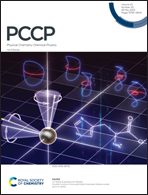The global minimum of Ag30: a prolate spheroidal structure predicted using a genetic algorithm with incomplete local optimizations at the DFT level†
Abstract
Genetic algorithms have been widely used to explore global minimum points of atomic clusters, and their incorporation with ab initio calculations (including density functional theory methods) as local optimization approaches increases their ability to accurately locate the global minimum points on complicated potential energy surfaces. However, the local optimizations using ab initio calculations significantly increase the computational cost relative to those based on empirical or semi-empirical calculations. Herein, we develop a genetic algorithm program with an incomplete local optimization strategy at the DFT level. Using several representative clusters as test examples, this program showed high efficiency in locating their global minimum points. The low-lying isomers of Ag30 were explored using this program, and the determined global minimum is a prolate spheroidal structure. The elongated spheroidal shape causes degeneracy lifting of the free electron shells, and endows Ag30 with a large HOMO–LUMO gap. The sharp increase of silver clusters’ reactivity around the sizes with 30 valence electrons observed in our previous experiments could be correlated with this theoretical figure.



 Please wait while we load your content...
Please wait while we load your content...